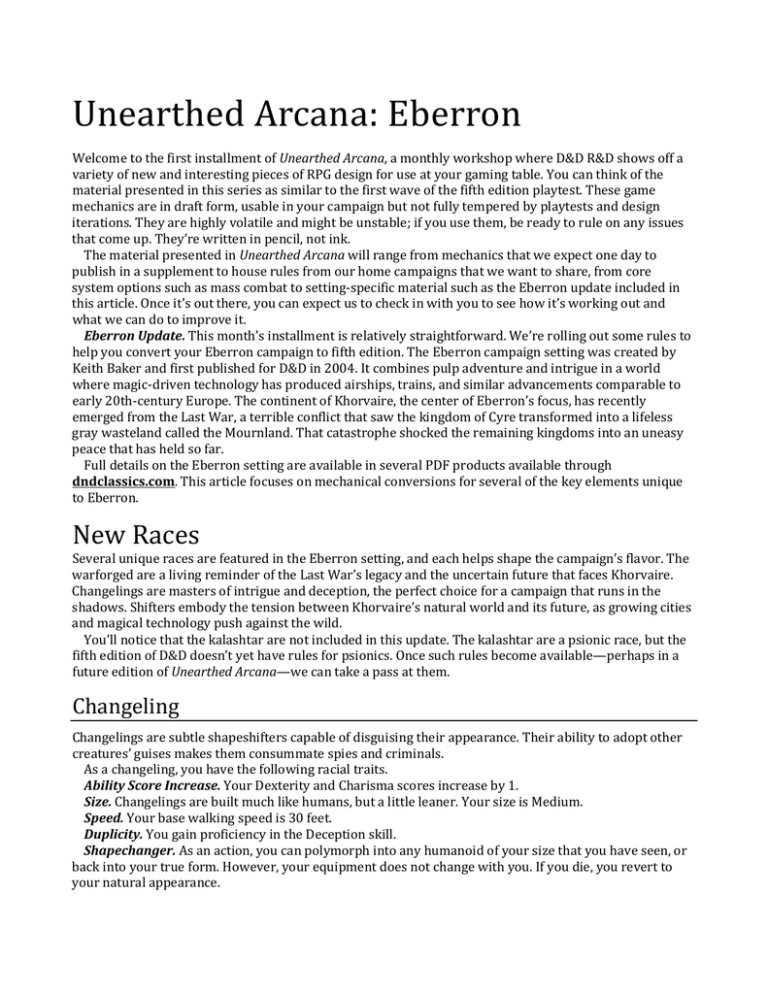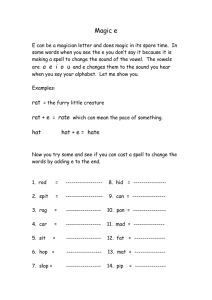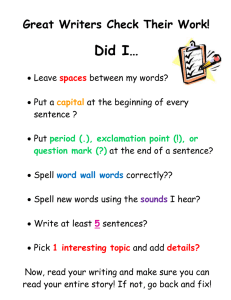Unearthed Arcana: Eberron
advertisement

Unearthed Arcana: Eberron Welcome to the first installment of Unearthed Arcana, a monthly workshop where D&D R&D shows off a variety of new and interesting pieces of RPG design for use at your gaming table. You can think of the material presented in this series as similar to the first wave of the fifth edition playtest. These game mechanics are in draft form, usable in your campaign but not fully tempered by playtests and design iterations. They are highly volatile and might be unstable; if you use them, be ready to rule on any issues that come up. They’re written in pencil, not ink. The material presented in Unearthed Arcana will range from mechanics that we expect one day to publish in a supplement to house rules from our home campaigns that we want to share, from core system options such as mass combat to setting-specific material such as the Eberron update included in this article. Once it’s out there, you can expect us to check in with you to see how it’s working out and what we can do to improve it. Eberron Update. This month’s installment is relatively straightforward. We’re rolling out some rules to help you convert your Eberron campaign to fifth edition. The Eberron campaign setting was created by Keith Baker and first published for D&D in 2004. It combines pulp adventure and intrigue in a world where magic-driven technology has produced airships, trains, and similar advancements comparable to early 20th-century Europe. The continent of Khorvaire, the center of Eberron’s focus, has recently emerged from the Last War, a terrible conflict that saw the kingdom of Cyre transformed into a lifeless gray wasteland called the Mournland. That catastrophe shocked the remaining kingdoms into an uneasy peace that has held so far. Full details on the Eberron setting are available in several PDF products available through dndclassics.com. This article focuses on mechanical conversions for several of the key elements unique to Eberron. New Races Several unique races are featured in the Eberron setting, and each helps shape the campaign’s flavor. The warforged are a living reminder of the Last War’s legacy and the uncertain future that faces Khorvaire. Changelings are masters of intrigue and deception, the perfect choice for a campaign that runs in the shadows. Shifters embody the tension between Khorvaire’s natural world and its future, as growing cities and magical technology push against the wild. You’ll notice that the kalashtar are not included in this update. The kalashtar are a psionic race, but the fifth edition of D&D doesn’t yet have rules for psionics. Once such rules become available—perhaps in a future edition of Unearthed Arcana—we can take a pass at them. Changeling Changelings are subtle shapeshifters capable of disguising their appearance. Their ability to adopt other creatures’ guises makes them consummate spies and criminals. As a changeling, you have the following racial traits. Ability Score Increase. Your Dexterity and Charisma scores increase by 1. Size. Changelings are built much like humans, but a little leaner. Your size is Medium. Speed. Your base walking speed is 30 feet. Duplicity. You gain proficiency in the Deception skill. Shapechanger. As an action, you can polymorph into any humanoid of your size that you have seen, or back into your true form. However, your equipment does not change with you. If you die, you revert to your natural appearance. Languages. You can speak, read, and write Common and two other languages of your choice. Shifter Traits Shifters are descended from humans and lycanthropes. Although they cannot fully change to animal form, they can take on animalistic features by a process they call shifting. As a shifter, you have the following racial traits. Ability Score Increase. Your Dexterity score increases by 1. Size. Shifters are about the same size as humans. Your size is Medium. Speed. Your base walking speed is 30 feet. Darkvision. Your lycanthropic heritage grants you the ability to see in dark conditions. You can see in dim light within 60 feet of you as if it were bright light, and in darkness as if it were dim light. You can’t discern color in darkness, only shades of gray. Shifting. On your turn, you can shift as a bonus action. Shifting lasts for 1 minute or until you end it on your turn as a bonus action. While shifting, you gain temporary hit points equal to your level + your Constitution bonus (minimum of 1). You also gain a feature that depends on your shifter subrace, described below. You must finish a short or long rest before you can shift again. Languages. You can speak, read, and write Common and Sylvan. Subrace. Several subraces of shifter exist, each with its own animalistic features. Choose one of the options below. Beasthide As a beasthide shifter, you are especially tough and persistent in battle. Ability Score Increase. Your Constitution score increases by 1. Shifting Feature. While shifting, you gain a +1 bonus to AC. Cliffwalk Your cliffwalk heritage grants you the agility of a mountain goat. Ability Score Increase. Your Dexterity score increases by 1. Shifting Feature. While shifting, you gain a climb speed of 30 feet. Longstride Longstride shifters are fleet and elusive. Ability Score Increase. Your Dexterity score increases by 1. Shifting Feature. While shifting, you can use the Dash action as a bonus action. Longtooth As a longtooth shifter, you are a ferocious combatant. Ability Score Increase. Your Strength score increases by 1. Shifting Feature. While shifting, you can make a bite attack as an action. This is a melee weapon attack that uses Strength for its attack roll and damage bonus and deals 1d6 piercing damage. If this attack hits a target that is your size or smaller, the target is also grappled. Razorclaw As a razorclaw shifter, you make swift, slashing strikes in battle. Ability Score Increase. Your Dexterity score increases by 1. Shifting Feature. While shifting, you can make an unarmed strike as a bonus action. You can use your Dexterity for its attack roll and damage bonus, and this attack deals slashing damage. Wildhunt Your wildhunt heritage makes you a consummate tracker and survivor. Ability Score Increase. Your Wisdom score increases by 1. Shifting Feature. While shifting, you gain advantage on all Wisdom-based checks and saving throws. Warforged The warforged were made as the ideal soldiers to serve in the devastating Last War. Although they are constructs, they have much in common with living creatures, including emotions and social bonds, and perhaps even souls. Traits As a warforged, you have the following racial traits. Ability Score Increase. Your Strength and Constitution scores increase by 1. Size. Warforged are generally broader and heavier than humans. Your size is Medium. Speed. Your base walking speed is 30 feet. Composite Plating. Your construction incorporates wood and metal, granting you a +1 bonus to Armor Class. Living Construct. Even though you were constructed, you are a living creature. You are immune to disease. You do not need to eat or breathe, but you can ingest food and drink if you wish. Instead of sleeping, you enter an inactive state for 4 hours each day. You do not dream in this state; you are fully aware of your surroundings and notice approaching enemies and other events as normal. Languages. You can speak, read, and write Common and one other language of your choice. New Wizard Tradition: Artificer Artificers are a key part of the world of Eberron. They illustrate the evolution of magic from a wild, unpredictable force to one that is becoming available to the masses. Magic items are part of everyday life in the Five Nations of Khorvaire; with an artificer in your party, they become part of every adventuring expedition. The artificer was a separate class in prior editions of the Eberron setting, a melee combatant who specialized in mystically enhanced arms and armor. The fifth edition rules treat the artificer as a new wizard tradition that focuses on mystical invention, which you can choose starting at 2nd level. Artificer Summary Wizard Level 2nd 6th 10th 14th Arcane Tradition Feature Infuse potions, infuse scrolls Infuse weapons and armor Superior artificer Master artificer Infuse Potions Starting at 2nd level, you can produce magic potions. You spend 10 minutes focusing your magic on a vial of mundane water and expend a spell slot to transform it into a potion. Once you have expended a spell slot to create a potion, you cannot regain that slot until the potion is consumed or after 1 week, at which time the potion loses its effectiveness. You can create up to three potions at a time; creating a fourth potion causes the oldest currently active one to immediately lose its potency. If that potion has been consumed, its effects immediately end. The spell slot you expend determines the type of potion you can create. See chapter 7 of the Dungeon Master’s Guide for complete rules on potions. Spell Slot 1st 2nd 3rd 4th Potion Created Climbing, growth, or healing Mind reading or greater healing Invisibility, superior healing, or water breathing Resistance Infuse Scrolls At 2nd level, you can also tap into your reserves of magical energy to create spell scrolls. You can use your Arcane Recovery ability to create a scroll instead of regaining expended spell slots. You must finish a short rest, then spend 10 minutes with parchment, quill, and ink to create a spell scroll containing one spell chosen from those you know. Subtract the spell’s level from the total levels worth of slots you regain using Arcane Recovery. This reduction to your Arcane Recovery applies until you use the scroll and then finish a long rest. Infuse Weapons and Armor Beginning at 6th level, you can produce magic weapons and armor. You spend 10 minutes focusing your magic on a mundane weapon, suit of armor, shield, or bundle of twenty pieces of ammunition, and expend a spell slot to infuse it with magical energy. The magic item retains its enhancement for 8 hours or until used (in the case of magic ammunition). You can infuse only one item at a time; if you infuse a second one, the first immediately loses its potency. Once you have expended a spell slot to create such an item, you cannot regain that slot until the item becomes nonmagical. The spell slot you expend determines the type of weapon, armor, or shield you can create. Spell Slot 2nd 3rd 4th 5th 6th Item Created +1 ammunition (20 pieces) +1 weapon or +1 shield +1 armor +2 weapon or +2 ammunition (20 pieces) +2 armor Superior Artificer Starting at 10th level, you can create a second magic weapon, suit of armor, shield, or bundle of ammunition using your Infuse Weapons and Armor ability. Attempting to infuse a third item causes the oldest one to immediately lose its potency. You can also create one additional potion or scroll using Infuse Potions or Infuse Scrolls. Master Artificer On reaching 14th level, your mastery of arcane magic allows you to produce a variety of magic items. You can create a single item chosen from Magic Item Tables A and B in chapter 7 of the Dungeon Master’s Guide. It takes you 1 week to produce such an item, and you must rest for 1 month before using this ability to craft another item. Action Points The Eberron campaign setting introduced this concept to reflect characters who are larger-than-life heroes destined for great things. Action points allow a player to add a bonus on any d20 roll so that characters can dodge or at least mitigate the effects of bad luck. This rule inspired the “Hero Points” optional rule presented in chapter 9 of the Dungeon Master’s Guide. You start with 5 action points at 1st level. Each time you gain a level, you lose any unspent action points and gain a new total equal to 5 + half your level. You can spend an action point whenever you roll a d20 to make an attack roll, an ability check, or a saving throw. You don’t have to decide until after you make the roll and learn if it succeeded or failed. If you spend an action point, roll a d6 and add it to your d20 result, possibly changing a failure into a success. You can spend only 1 action point per roll. In addition, whenever you fail a death saving throw, you can spend an action point to make it a success. Dragonmarks Dragonmarks are elaborate skin patterns, similar to tattoos, that grant their bearers innate spellcasting abilities. Each type of mark is tied to large, extended families that each control a different industry or trade in Eberron. Not every member of a given family possesses a dragonmark; conversely, merely possessing a dragonmark does not grant special status within the house. You must use a feat to gain a dragonmark. You are a member of its corresponding dragonmarked house (or houses, in the case of the Mark of Shadow) and must belong to its listed race or races. Dragonmarks Mark Detection Finding Handling Healing Hospitality Making Passage Scribing Sentinel Shadow Shadow Storm Warding House Medani Tharashk Vadalis Jorasco Ghallanda Cannith Orien Sivis Deneith Phiarlan Thuranni Lyrander Kundarak Race Half-elf Half-orc, human Human Halfling Halfling Human Human Gnome Human Elf Elf Half-elf Dwarf Influence Warning Guild Finders Guild Handlers Guild Healers Guild Hostelers Guild Tinkers Guild, Fabricators Guild Couriers Guild, Transportation Guild Notaries Guild, Speakers Guild Blademarks Guild, Defenders Guild Entertainers and Artisans Guild Shadow Network Windwrights Guild, Raincallers Guild Banking Guild, Warding Guild Aberrant dragonmarks occasionally appear, which are not tied to the dragonmarked houses and have a variety of effects. To represent an aberrant dragonmark for your character, choose the Magic Initiate feat from the Player’s Handbook. New Feat: Dragonmark You have a magical mark that indicates you are a member of one of the dragonmarked houses. Select one of the options from the Dragonmarks table. You gain the ability to innately cast spells and cantrips, as summarized in the Dragonmark Benefits table, using the spellcasting ability listed under the Ability column. You cast each spell at its lowest level. Once you cast a given spell this way, you must finish a long rest before you can cast it innately again. You must still expend any material components. Your dragonmark confers the following benefits: • When you first take this feat, you gain the least dragonmark. You learn the spells listed under the Least column. • • At 5th level and higher, your mark becomes more potent, improving to lesser dragonmark. You also learn the spell listed under the Lesser column. At 9th level and higher, your mark’s power increases again, becoming a greater dragonmark. You also learn the spell listed under the Greater column. Dragonmark Benefits Mark Detection Finding Handling Healing Hospitality Making Passage Scribing Sentinel Shadow Storm Warding Ability Wisdom Wisdom Wisdom Wisdom Charisma Intelligence Intelligence Intelligence Wisdom Charisma Intelligence Intelligence Least Detect magic, mage hand Identify, mage hand Druidcraft, speak with animals Cure wounds, spare the dying Friends, unseen servant Identify, mending Expeditious retreat, light Comprehend languages, message Blade ward, compelled duel Dancing lights, disguise self Fog cloud, shocking grasp Alarm, resistance Lesser Detect thoughts Locate object Beast sense Lesser restoration Rope trick Magic weapon Misty step Sending Blur Darkness Gust of wind Arcane lock Greater Clairvoyance Clairvoyance Conjure animals Revivify Leomund’s tiny hut Fabricate Teleportation circle Tongues Protection from energy Nondetection Sleet storm Magic circle Mike Mearls is the senior manager for the D&D research and design team. He was one of the lead designers for the fifth edition of D&D. His other credits include the Castle Ravenloft board game, Monster Manual 3 for fourth edition, and Player’s Handbook 2 for third edition.


